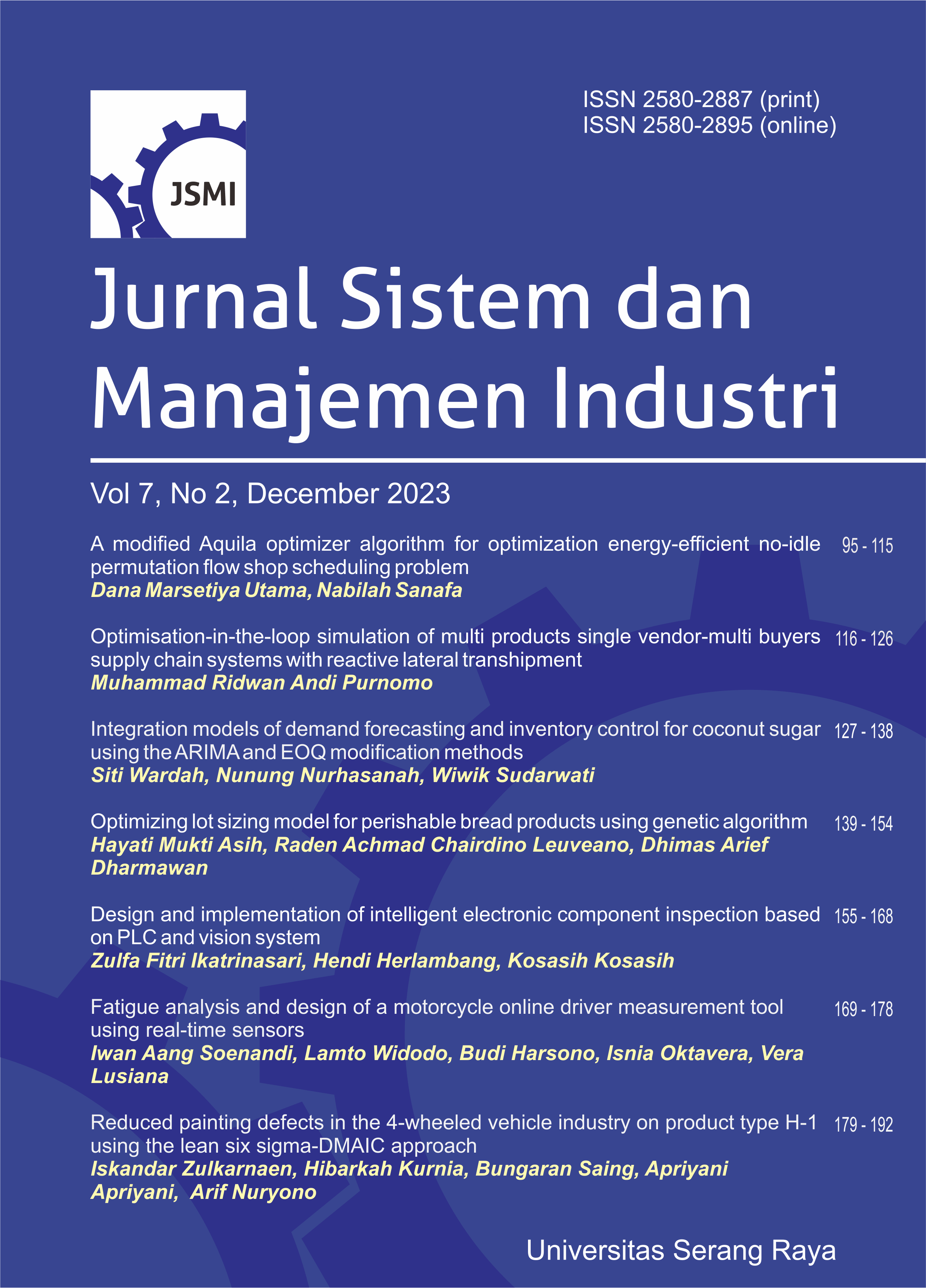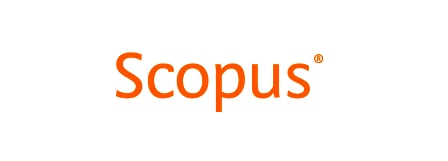Fatigue analysis and design of a motorcycle online driver measurement tool using real-time sensors
DOI:
https://doi.org/10.30656/jsmi.v7i2.7500Keywords:
Fatigue conditions, Fatigue sensors, Motorcycle online drivers, Real-time monitoringAbstract
Work fatigue is an important aspect and is very influential in determining the level of accidents, especially motorbike accidents. According to WHO, almost 30% of all deaths due to road accidents involve two- and three-wheelÂed motorized vehicles, such as motorbikes, mopeds, scooters and electric bicycles (e-bikes), and the number continues to increase. MotorÂcycles dominate road deaths in many low- and middle-income countries, where nine out of ten traffic accident deaths occur among motorcyclists, as in Indonesia. However, until now, in Indonesia, there has been no monitorÂing system capable of identifying fatigue in motorbike drivers in the transportation sector. This research aims to determine fatigue patterns based on driver working hours and create a sensor system to monitor fatigue measurements in real-time to reduce the number of accidents. The research began with processing questionnaire data with Pearson correlation, which showed a close relationship between driver fatigue and driving time and a close relationship between fatigue and increased heart rate and sweating levels. From calibration tests with an error of 3% and direct measurements of working conditions, it was found that two-wheeled vehicle driver fatigue occurs after 2-3 hours of work. With a measurement system using the Box Whiskers analysis method, respondents' working conditions can also be deÂterÂmined, which are divided into 4 zones, namely zone 1 (initial condition or good condition), zone 2 a declining condition, zone 3 a tired condition and zone 4 is a resting condition. Hopefully, this research will identify fatiÂgue zones correctly and reduce the number of accidents because it can idenÂtify tired drivers so they do not have to force themselves to continue working and driving their motorbikes. As a conclusion from this research, a measureÂment system using two sensors, such as ECG and GSR can identify work fatigue zones well and is expected to reduce the number of accidents due to work fatigue.
Downloads
References
World Health Organization, ‘New global guidelines to curb motorcycle crash deaths’, World Health Organization, 2022. https://www.who.int/news/item/10-10-2022-new-global-guidelines-to-curb-motorcycle-crash-deaths.
Komite Nasional Keselamatan Transportasi, ‘KNKT Tekankan Setiap Orang Agar Peduli Akan Keselamatan’, Komite Nasional Keselamatan Transportasi, 2022. https://knkt.go.id/news/read/knkt-tekankan-setiap-orang-agar-peduli-akan-keselamatan.
Y. Umniyatun, M. I. Nurmansyah, Y. Farradika, T. B. Purnama, and D. N. Hidayat, ‘Motorcycle risky behaviours and road accidents among adolescents in Jakarta metropolitan area, Indonesia’, Int. J. Inj. Contr. Saf. Promot., vol. 28, no. 3, pp. 339–346, Jul. 2021, doi: https://doi.org/10.1080/17457300.2021.1928229.
I. Ashraf, S. Hur, M. Shafiq, and Y. Park, ‘Catastrophic factors involved in road accidents: Underlying causes and descriptive analysis’, PLoS One, vol. 14, no. 10, p. e0223473, Oct. 2019, doi: https://doi.org/10.1371/journal.pone.0223473.
F. Guo et al., ‘The effects of age on crash risk associated with driver distraction’, Int. J. Epidemiol., vol. 46, no. 1, p. dyw234, Oct. 2016, doi: https://doi.org/10.1093/ije/dyw234.
L. Cerniglia et al., ‘Motor vehicle accidents and adolescents: An empirical study on their emotional and behavioral profiles, defense strategies and parental support’, Transp. Res. Part F Traffic Psychol. Behav., vol. 35, pp. 28–36, Nov. 2015, doi: https://doi.org/10.1016/j.trf.2015.09.002.
H. Lee, J. Lee, and M. Shin, ‘Using Wearable ECG/PPG Sensors for Driver Drowsiness Detection Based on Distinguishable Pattern of Recurrence Plots’, Electronics, vol. 8, no. 2, p. 192, Feb. 2019, doi: https://doi.org/10.3390/electronics8020192.
H. Iwamoto, K. Hori, K. Fujiwara, and M. Kano, ‘Real-driving-implementable drowsy driving detection method using heart rate variability based on long short-term memory and autoencoder’, IFAC-PapersOnLine, vol. 54, no. 15, pp. 526–531, 2021, doi: https://doi.org/10.1016/j.ifacol.2021.10.310.
H. Al-Libawy, A. Al-Ataby, W. Al-Nuaimy, and M. A. Al-Taee, ‘HRV-based operator fatigue analysis and classification using wearable sensors’, in 2016 13th International Multi-Conference on Systems, Signals & Devices (SSD), Mar. 2016, pp. 268–273, doi: https://doi.org/10.1109/SSD.2016.7473750.
D. Dogan, S. Bogosyan, and T. Acarman, ‘Evaluation of driver stress level with survey, galvanic skin response sensor data, and force-sensing resistor data’, Adv. Mech. Eng., vol. 11, no. 12, p. 168781401989155, Dec. 2019, doi: https://doi.org/10.1177/1687814019891555.
S. Murugan, J. Selvaraj, and A. Sahayadhas, ‘Detection and analysis: driver state with electrocardiogram (ECG)’, Phys. Eng. Sci. Med., vol. 43, no. 2, pp. 525–537, Jun. 2020, doi: https://doi.org/10.1007/s13246-020-00853-8.
A. Othmani et al., ‘EEG-based neural networks approaches for fatigue and drowsiness detection: A survey’, Neurocomputing, vol. 557, p. 126709, Nov. 2023, doi: https://doi.org/10.1016/j.neucom.2023.126709.
K. Fujiwara et al., ‘Heart Rate Variability-Based Driver Drowsiness Detection and Its Validation With EEG’, IEEE Trans. Biomed. Eng., vol. 66, no. 6, pp. 1769–1778, Jun. 2019, doi: https://doi.org/10.1109/TBME.2018.2879346.
M. Hendra, D. Kurniawan, R. Vina Chrismiantari, T. Pambudi Utomo, and N. Nuryani, ‘Drowsiness detection using heart rate variability analysis based on microcontroller unit’, J. Phys. Conf. Ser., vol. 1153, no. 1, p. 012047, Feb. 2019, doi: https://doi.org/10.1088/1742-6596/1153/1/012047.
J. Halomoan, K. Ramli, D. Sudiana, T. S. Gunawan, and M. Salman, ‘A New ECG Data Processing Approach to Developing an Accurate Driving Fatigue Detection Framework with Heart Rate Variability Analysis and Ensemble Learning’, Information, vol. 14, no. 4, p. 210, Mar. 2023, doi: https://doi.org/10.3390/info14040210.
R. Buendia, F. Forcolin, J. Karlsson, B. Arne Sjöqvist, A. Anund, and S. Candefjord, ‘Deriving heart rate variability indices from cardiac monitoring—An indicator of driver sleepiness’, Traffic Inj. Prev., vol. 20, no. 3, pp. 249–254, Mar. 2019, doi: https://doi.org/10.1080/15389588.2018.1548766.
G. Lenis, P. Reichensperger, D. Sommer, C. Heinze, M. Golz, and O. Dössel, ‘Detection of microsleep events in a car driving simulation study using electrocardiographic features’, Curr. Dir. Biomed. Eng., vol. 2, no. 1, pp. 283–287, Sep. 2016, doi: https://doi.org/10.1515/cdbme-2016-0063.
A. Persson, H. Jonasson, I. Fredriksson, U. Wiklund, and C. Ahlstrom, ‘Heart Rate Variability for Classification of Alert Versus Sleep Deprived Drivers in Real Road Driving Conditions’, IEEE Trans. Intell. Transp. Syst., vol. 22, no. 6, pp. 3316–3325, Jun. 2021, doi: https://doi.org/10.1109/TITS.2020.2981941.
J. Vicente, P. Laguna, A. Bartra, and R. Bailón, ‘Drowsiness detection using heart rate variability’, Med. Biol. Eng. Comput., vol. 54, no. 6, pp. 927–937, Jun. 2016, doi: https://doi.org/10.1007/s11517-015-1448-7.
L. Wang, J. Li, and Y. Wang, ‘Modeling and Recognition of Driving Fatigue State Based on R-R Intervals of ECG Data’, IEEE Access, vol. 7, pp. 175584–175593, 2019, doi: https://doi.org/10.1109/ACCESS.2019.2956652.
K. Lu, A. Sjörs Dahlman, J. Karlsson, and S. Candefjord, ‘Detecting driver fatigue using heart rate variability: A systematic review’, Accid. Anal. Prev., vol. 178, p. 106830, Dec. 2022, doi: https://doi.org/10.1016/j.aap.2022.106830.
T. Kundinger, N. Sofra, and A. Riener, ‘Assessment of the Potential of Wrist-Worn Wearable Sensors for Driver Drowsiness Detection’, Sensors, vol. 20, no. 4, p. 1029, Feb. 2020, doi: https://doi.org/10.3390/s20041029.
F. Shaffer and J. P. Ginsberg, ‘An Overview of Heart Rate Variability Metrics and Norms’, Front. Public Heal., vol. 5, p. 258, Sep. 2017, doi: https://doi.org/10.3389/fpubh.2017.00258.
R. W. Cooksey, ‘Descriptive Statistics for Summarising Data’, in Illustrating Statistical Procedures: Finding Meaning in Quantitative Data, Singapore: Springer Singapore, 2020, pp. 61–139, doi: https://doi.org/10.1007/978-981-15-2537-7_5.
T. M. Franke, T. Ho, and C. A. Christie, ‘The Chi-Square Test’, Am. J. Eval., vol. 33, no. 3, pp. 448–458, Sep. 2012, doi: https://doi.org/10.1177/1098214011426594.
P. Schober, C. Boer, and L. A. Schwarte, ‘Correlation Coefficients: Appropriate Use and Interpretation’, Anesth. Analg., vol. 126, no. 5, pp. 1763–1768, May 2018, doi: https://doi.org/10.1213/ANE.0000000000002864.
F. Esgalhado, A. Batista, V. Vassilenko, S. Russo, and M. Ortigueira, ‘Peak Detection and HRV Feature Evaluation on ECG and PPG Signals’, Symmetry (Basel)., vol. 14, no. 6, p. 1139, Jun. 2022, doi: https://doi.org/10.3390/sym14061139.
M. Elgendi, ‘Fast QRS Detection with an Optimized Knowledge-Based Method: Evaluation on 11 Standard ECG Databases’, PLoS One, vol. 8, no. 9, p. e73557, Sep. 2013, doi: https://doi.org/10.1371/journal.pone.0073557.
A. K. Dohare, V. Kumar, and R. Kumar, ‘An efficient new method for the detection of QRS in electrocardiogram’, Comput. Electr. Eng., vol. 40, no. 5, pp. 1717–1730, Jul. 2014, doi: https://doi.org/10.1016/j.compeleceng.2013.11.004.
M. L. McHugh, ‘The Chi-square test of independence’, Biochem. Medica, vol. 23, no. 2, pp. 143–149, 2013, doi: https://doi.org/10.11613/BM.2013.018.
S. Z. H. Kazmi et al., ‘Inverse Correlation between Heart Rate Variability and Heart Rate Demonstrated by Linear and Nonlinear Analysis’, PLoS One, vol. 11, no. 6, p. e0157557, Jun. 2016, doi: https://doi.org/10.1371/journal.pone.0157557.
R. L. Nuzzo, ‘The Box Plots Alternative for Visualizing Quantitative Data’, PM&R, vol. 8, no. 3, pp. 268–272, Mar. 2016, doi: https://doi.org/10.1016/j.pmrj.2016.02.001.
J. E. V. Ferreira, R. M. Miranda, A. F. Figueiredo, J. P. Barbosa, and E. M. Brasil, ‘Box-and-Whisker Plots Applied to Food Chemistry’, J. Chem. Educ., vol. 93, no. 12, pp. 2026–2032, Dec. 2016, doi: https://doi.org/10.1021/acs.jchemed.6b00300.
Downloads
Published
Issue
Section
License
All articles in Jurnal Sistem dan Manajemen Industri can be disseminated provided they include the identity of the article and the source of the article Jurnal Sistem dan Manajemen Industri. The publisher is not responsible for the contents of the article. The content of the article is the sole responsibility of the author
Jurnal Sistem dan Manajemen Industri is licensed under a Creative Commons Attribution-NonCommercial-ShareAlike 4.0 International License.
















1.png)
.png)
.png)
.png)


